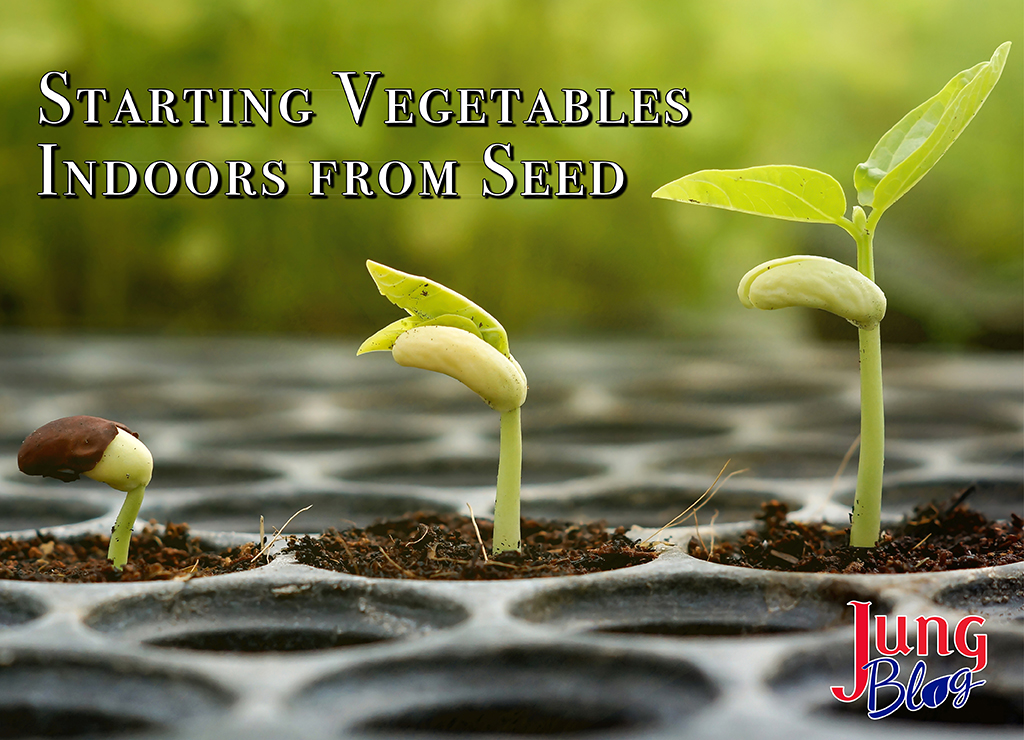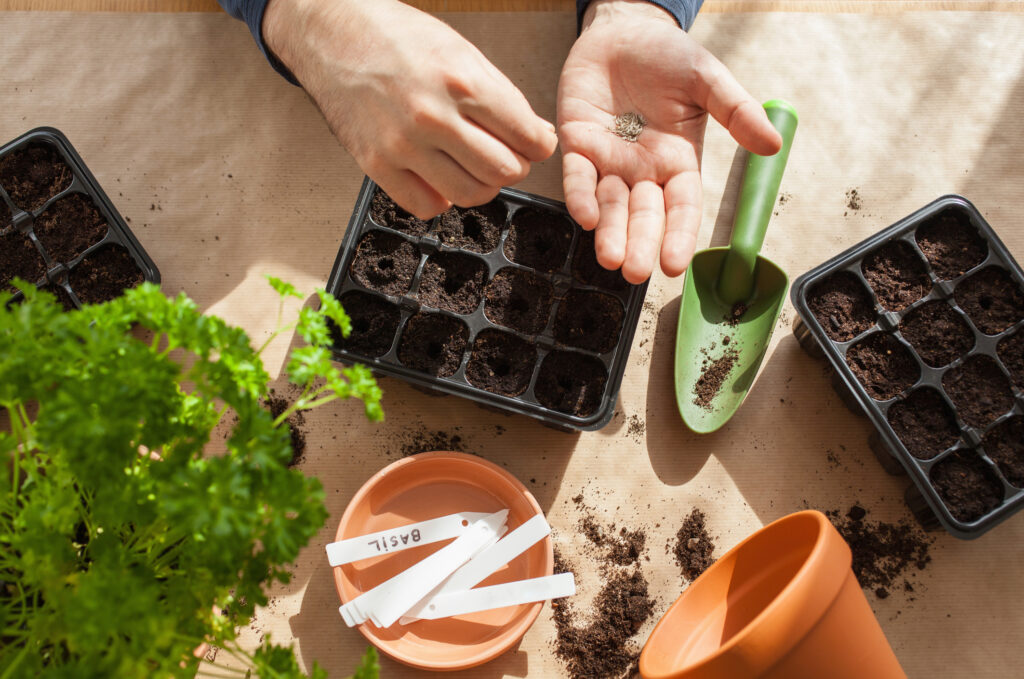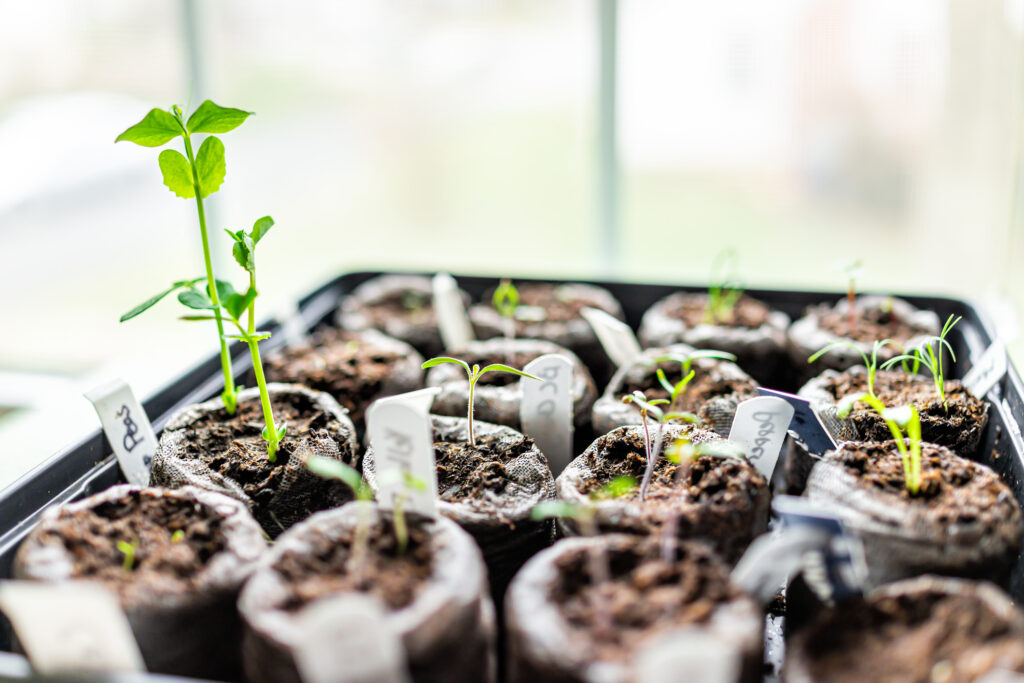
When I was younger, I discovered a packet of cucumber seeds in the kitchen. Having never grown a plant from seed before, I was eager to plant one and see what would happen. I quickly found a container in the garage and sowed the seed. A few days later, the seedling emerged from the soil and later became a full-sized plant that produced the first cucumber I had ever grown. The excitement of watching one seed grow began my interest in gardening and I’ve been hooked ever since. Growing a plant from seed is one of the most exciting experiences of gardening. Starting vegetable seeds indoors is a great way to begin the spring season and get a head start on creating a productive garden.
Getting Started

The cold days of winter make us eager to begin planting, but it’s important to start seedlings at the proper time. Sowing seed too early will result in large plants that are difficult to care for indoors. Vegetables take varying amounts of time to grow from seed.
The chart below will give you an idea of when seeds can be planted indoors in southern Wisconsin, and when to transplant them to the garden. The date for planting outside can fluctuate based on weather, making it important to monitor the forecast around planting time. For those who live further north, these dates should be pushed back 1-2 weeks.
| Vegetable | Plant Seed Indoors | Transplant Outside |
| Broccoli | March 15 | May 1 |
| Cabbage | March 15 | May 1 |
| Cauliflower | March 15 | May 1 |
| Celery | March 15 | May 20 |
| Eggplant | March 15 | June 1 |
| Lettuce | April 1 | April 25 |
| Pepper | April 1 | May 25 |
| Tomatoes | April 15 | May 20 |
*Note – This chart has approximate planting and transplanting dates for the southern Wisconsin area
Some vegetables grow better when directly seeded in the garden. These include root crops, such as carrots, beets, and potatoes. Veggies that grow quickly from seed can also be sown directly in the garden. A few examples are cucumbers, peas, squash, and corn.
Create The Right Environment

Plants require several elements to thrive. These include proper levels of moisture, light, and temperature. A professional vegetable grower once told me that moisture may be the leading factor that determines the success of a crop. Proper moisture levels begin with the potting mix. Soil from the garden should never be used to grow seedlings or any plants in containers. A good potting mix will drain well while retaining some moisture. Moisture levels are vital because excess moisture can lead to root rot, while lack of moisture leads to stunted growth or dead plants. Before planting, it’s a good idea to moisten the soil if it’s dry. This will help the potting mix absorb moisture after the seed is planted. Always plant in trays or cells with drainage holes.
It’s easy to tell when a plant isn’t receiving enough light. The plants tend to look tall and spindly, with narrow stems that struggle to stand upright. Providing seedlings with the proper amount of light is vital for creating healthy plants that can withstand the forces of nature. For optimal results, place seedlings in a southern-facing window that receives ample sunlight. If none is available, you can use LED or fluorescent grow lights. The lights should be placed about 3-4 inches above the plants. When the lights are set up, observe the plants in the coming days to check if the lights are the correct distance from the plants. If the lights are too close, the leaves may burn, while having the lights too far away will lead to leggy growth. Grow lights should be turned on 12-16 hours a day for optimal growth.
Some veggies require warm soil to germinate and grow, while others prefer cool temperatures. Warm-season vegetables, like tomatoes, peppers, and eggplant prefer soil temperatures of 65-75° to germinate and grow. The seeds may germinate at lower temperatures, but their growth will be delayed. Cool-season vegetables prefer temperatures of 50-60°. A heating mat will help maintain warm soil temperatures for warm-season vegetables.
Sowing The Seed

One resource that should be utilized before planting is the seed packet. The seed packet gives you information about the variety and the time required for the plant to reach maturity. Maturity is when you can harvest the first crop. Maturity times may vary slightly each year, based on weather conditions. Seed packets also tell you the correct planting depth and growing conditions required for the plants.
Seeds are typically sown in cell trays, which allow you to keep the seedlings organized and separated when sowing. 2-3 seeds should be sown in each cell, which ensures you’ll have the correct number of seedlings if some don’t germinate. Refer to the seed packet to see how deep the seeds should be planted. Once the seeds are planted, lightly cover them with soil, and carefully water them.
Seedlings have two types of leaves. The first pair of leaves to appear is the seed leaves or cotyledon. The cotyledon looks similar on many different types of vegetables. The next leaf that appears is the “true” leaf. The true leaf has a noticeably different shape than the cotyledon. The leaves that are produced in the future will be shaped like the true leaf. Once the true leaf emerges, it’s time to thin the seedlings to one plant per cell.
The growth of the true leaf is a good indication that it’s time to transplant into larger cells or pots. Using four-inch pots is ideal for most veggies until it’s time to move them into the garden. When transplanting, be sure to handle the seedling by the rootball to avoid damaging the stem. Continue monitoring the plants to ensure they’re receiving enough light and moisture. Once the plants have formed a second set of true leaves, they can be fertilized every 2 weeks with a balanced fertilizer, such as 15-30-15.
Eventually, it will be time to transplant seedlings into the garden, but first, they should be acclimated to outdoor conditions. This ensures the plants are prepared to be exposed to the elements of the garden. Begin the acclimation period by placing the seedlings in a calm, shady site for a few hours each day, then bringing them inside. Gradually expose them to increased amounts of sunlight and wind every day for 2-3 weeks. Once this process is completed, they should be ready for planting in the garden.
Growing veggies from seed is an excellent way to begin the growing season. This process allows us to learn about plants and experience the joy of growing them from seed to harvest.
Other Recommended Reading

- Seed Starting FAQ
- Transplanting Seedlings
- 14 Vegetables To Plant For Fall
- 22 Easy To Grow Vegetable Seeds
- Seed Germination Guide
- Starting Annual Flower Seeds Indoors
- Sow Seeds Of Victory: Planting A Victory Garden
- Seed Saving: 4 Important Questions To Consider Before Saving
At Jung Seed Co, we strive to be your go-to guide for all your gardening needs. Our YouTube channel Jung Garden Center now includes our new video series All Things Green where our experts provide gardening tips for all levels of gardeners. When you need reliable gardening advice, turn to the trusted experts at Jung.

View our new catalog online or browse our website for all of your gardening favorites. To receive info on new products, exclusive deals, and specials, be sure to sign up for our weekly email. Join our Facebook page, to discuss all things gardening!
About the Author: Matthew Olson is a professional horticulturist and garden writer. He has a bachelor’s degree in horticulture from UW-River Falls and is a certified professional with the Minnesota Nursery and Landscape Association. His enthusiasm for plants and the outdoors brought him to the green industry. He regularly writes articles about gardening for both gardeners and industry professionals. He can be reached at matt@mattolsonhorticulture.com